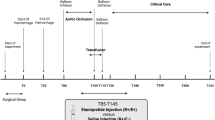Abstract
Objective: The present study was designed to assess whether pretreatment with nicorandil enhanced myocardial protection provided by cold (15°C) high-potassium (25 mmol/l) blood cardioplegia during open heart surgery.Methods: Subjects were 40 patients with a variety of acquired heart diseases undergoing cardiac surgery involved cardiopulmonary bypass. They were randomly divided into two groups, 25 pretreated nicorandil (0.3 mg/kg) 30 minutes before aortic cross clamping, 15 not pretreated. After aortic cross clamping, the initial dose of cardioplegic solution (10 ml/kg) was administered through the ascending aorta and supplemental doses of cardioplegia (5 ml/kg) given each 30 minutes thereafter. Preoperative and postoperative cardiac troponin-T, myosin light chain 1 and cardiac enzymes were measured and hemodynamic data recorded.Results: Postoperative serum creatine kinase and myosin light chain 1 were significantly lower in the nicorandil pretreatment group than in controls. Serum glutamic oxalacetic transaminase and troponin-T were lower and cardiac output was higher after surgery in the nicorandil group, although not statistically significantConclusion: This data suggests that pretreatment with nicorandil enhances the myocardial protection achieved by cold blood cardioplegia.
Similar content being viewed by others
References
Murry CE, Jennings RB, Reimer K. Preconditioning with ischemia: a delay of lethal injury in ischemic myocardium. Circulation 1986; 74: 1124–36.
Galie N, Guarnieri C, Ussia GP, Zimarino M, Traini AM, Parlangeli R, et al. Limitation of myocardial infact size by nicorandil after sustained ischemia in pigs. J Cardiovasc Pharmacol 1995; 26: 477–84.
Yao Z, Gross GJ. Role of nitric oxide, muscarinic receptors, and the ATP-sensitive K channel in mediating the effects of acetylcholine to mimic preconditioning in dogs. Circ Res 1993; 73: 1193–201.
Tomai F, Crea F, Gaspardone A, Versaci F, De Paulis R, Penta de Peppo A, et al. Ischemic preconditioning during coronary angioplesty is prevented by glibenclamide, a selective ATP-sensitive K channel blocker. Circulation 1994; 90: 700–5.
Menasche P, Kevelaitis E, Mouse C, Grousset C, Piwnica A, Bloch G. Preconditioning with potassium channel openers: a new concept for enhancing myocardial protection? J Thorac Cardiovasc Surg 1995; 110: 1606–14.
Gross GJ, Auchampagh JA, Maruyama M, Warltier DC, Pieper GM. Cardioprotective effects of nicorandil. J Cardiovasc Parmacol 1992; 20 (Suppl 3): S22–8.
Taira N. Nicorandil as a hybrid between nitrates and potassium channel activators. Am J Cardiol 1989; 63: 18J-24J.
Sugimoto S, Pddu PE, Monti F, Schiariti M, Campa PP, Marino B. Pretreatment with the adenosine triphosphate-sensitive potassium channel opener nicorandil and improved myocardial protection during high-potassium cardioplegia hypoxia. J Thorac Cardiovasc Surg 1994; 108: 455–66.
Menache P, Mouse C, Grousset C. Is potassium channel opening an effective form of preconditioning before cardioplegia? Ann Thorac Surg 1996; 61: 1764–8.
Sugimoto S, Puddu PE, Monti F, Dawodn AA, del Monte F, Schiariti M, et al. Activation of ATP-dependent K Channels enhances myocardial protection due to high potassium cardioplegia: a force-frequency relationship study. J Mol Cell Cardiol 1995; 27: 1867–81.
Shigematsu S, Sato T, Abe T, Saikawa T, Sakata T, Arita M. Pharmacological evidence for the persistent activation of ATP-sensitive K channels in early phase of reperfusion and its protective role against myocardial stunning. Circulation 1995; 92: 2266–75.
Nakaya H, Takeda Y, Toshe N, Kanno M. Effects of ATP-sensitive K channel blockers on the action potential shortening in hypoxic and ischemic myocardium. Br J Pharmacol 1991; 103: 1019–26.
Grover GJ, Baird AJ, Sleph PG. Lack of a pharmacologic interaction between ATP-sensitive potassium channels and adenosine A1 receptors in ischemic rat heart. Cardiovasc Res 1996; 31: 511–7.
Maskal SL, Cohen NM, Hsia PW, Wechsler AS, Damiano RJ Jr. Hyperpolarized cardiac arrest with potassium-channel opener, apricalim. J Thorac Cardiovasc Surg 1995; 110: 1083–95.
Grover GJ. Activation of ATP-sensitive potassium channel openers in models of myocardial ischaemia. Cardiovasc Res 1994; 28: 778–89.
Author information
Authors and Affiliations
Rights and permissions
About this article
Cite this article
Li, Y., Iguchi, A., Tsuru, Y. et al. Nicorandil pretreatment and improved myocardial protection during cold blood cardioplegia. Jpn J Thorac Caridovasc Surg 48, 24–29 (2000). https://doi.org/10.1007/BF03218081
Received:
Accepted:
Issue Date:
DOI: https://doi.org/10.1007/BF03218081




